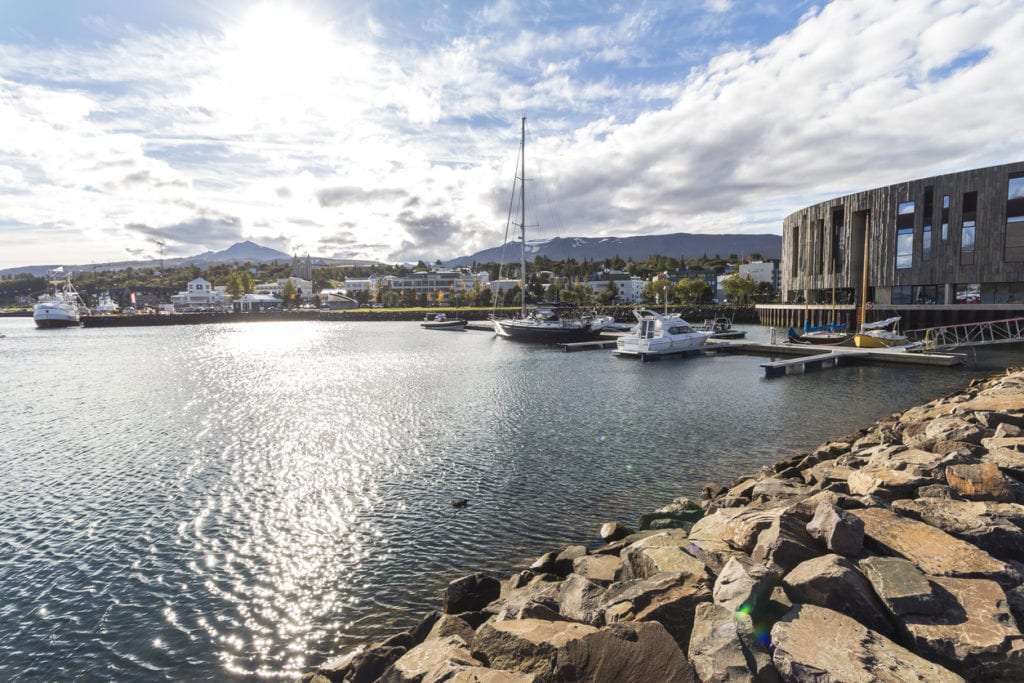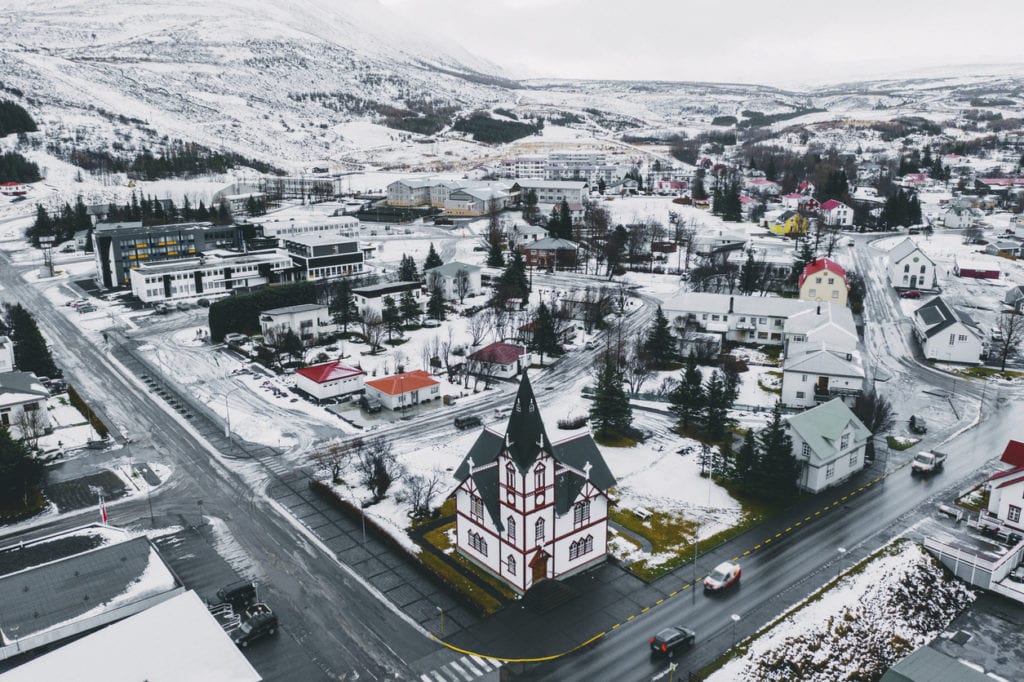Iceland is full of treasures to explore, from the Westfjords to the Golden Circle to the Snaefellsnes Peninsula. The north in Iceland is no exception. If you have the opportunity to venture there, you’ll enjoy a wide range of incredible sites in any season. Whether you have a few days or a month to explore, this is everything you’ll want to know about such a trip. Enjoy!
Akureyri

With so much to see and do, Akureyri is the perfect jumping-off point for your adventure in the north in Iceland. The museums alone could keep you busy for a week: there’s the Akureyri Art Museum, the Akureyri Museum of Industry, Into the Arctic, the Aviation Museum, and more. Don’t miss the town’s primary landmark, the Akureyrarkirkja—the incredible Lutheran church in the town center. The Old Town is a window into the city’s history, featuring the old theatre, primary school, and hospital, not to mention a selection of those museums! The botanical garden (summer months) and the Christmas garden (open all year!) are also enjoyable stops on your journey.
In the winter, Akureyri gives you great access to skiing (cross-country, downhill, and heli). There is also skating and more snow fun. If you’d prefer to watch, visit during the Iceland Winter Games and enjoy events like skiing, snow volleyball, and freestyle snow skating in the north in Iceland.
Kjarnaskógur Woods
Accessible by bus or taxi, Kjarnaskógur is just south of Akureyri and is one of the country’s most popular wooded areas. With biking and hiking trails (and, during the weather-permitting winter, cross-country skiing trails), picnic areas, playgrounds, and a volleyball court, it’s an ideal spot for a relaxing afternoon with friends or for quiet reflection on your own.
Goðafoss
This “waterfall of the gods” is a sight to be seen in the north in Iceland. Just about a half-hour’s drive from Akureyri, Goðafoss is part of the Skjálfandafljót River. For more waterfall magic, visit Dettifoss, generally considered the most powerful waterfall in Europe, as you continue your road trip around the northern region. You might even recognize it from the opening scene of the movie Prometheus.
Mývatn
The lake and surrounding area feature incredible hiking trails, bird watching, and more. If you happen to be visiting in the winter, Mývatn is a great place to see the Northern Lights. In May, you can explore the area on foot in the Mývatn Marathon! (There is also a half-marathon, 10k, and 3k race available.) Afterward, you can relax in the Mývatn Nature Baths. Hverfjall, the largest tephra crater in Europe, is nearby, as well; it was formed in a volcanic explosion some 2,500 years ago. It’s a great spot for hiking, and you’ll be treated with some spectacular views.
Krafla
Another highlight of the area near Mývatn is the Krafla caldera. (Hverfjall is in the southern part of this.) This active volcanic area is 10 kilometers long and two kilometers deep; the most recent eruption was in the 1970s. Here, the Krafla Power Station provides geothermal energy to the surrounding area (you can stop by the visitor’s center during the summer). The Víti Crater features a teal lake and a short walking trail from which you can appreciate the landscape. For a longer walk, the Leirhnjúkur lava fields offer collections of textures and colors to enjoy in the north in Iceland.
Námaskarð
North of the lake you’ll find Námaskarð, which is worth a visit for the unique landscape—though you probably won’t stay long because of the smell! The sulphuric mud is beautiful, but it’s smelly. Powerfully smelly. Still, you’ll be glad you stopped by to enjoy the unique sight.
Dimmuborgir
Meaning “dark cities” or “dark castles”, Dimmuborgir is a collection of volcanic rock formations near Mývatn. It comes with some dark folklore: it’s said to be the spot where Satan landed after he was booted out of heaven. However, even the Icelandic stories predating Christianity in the country associated this area with the underworld; there are also some entertaining legends about trolls you’ll want to hear. If the area looks familiar to you, it may be because you recognize it from a Game of Thrones episodes.
Ásbyrgi Canyon
This is a lovely spot for a quick hike or photo opportunity, and it comes with a colorful formation story:
“Legend has it that the canyon acquired its distinct horseshoe shape thanks to Sleipnir, the 8-legged flying horse of Norse god Odin. While Odin was out on a joy ride with Sleipnir one fine day, the horse accidentally touched one of its giant hooves onto the earth, creating the mighty canyon.”
It’s lush and beautiful, and with the unique rocks in the center, it’s another spot for some interesting acoustics.
Húsavík

This is the best place to go whale-watching in Iceland—indeed, it’s one of the best places in the world. Humpback, minke, and blue whales are the most common, but there have been 23 different whale species recorded in those Icelandic waters. Húsavík offers four different whale-watching companies to choose from; after your tour, there’s much more see and do! From bird watching to hiking to horseback riding, this little town and the surrounding area is a nature lover’s dream. After all that activity, the geothermal sea baths are the perfect way to relax in the north in Iceland.
Hljóðaklettar
After Húsavík, follow the loop of the highway along the coast then southeast to Hljóðaklettar, the unique basalt columns that make for a lovely short hike and experiments with sound: they’re named Echo Rocks for a reason. When you’re there, you’ll hear the river but you won’t be able to tell where the sound is coming from.
Skagafjörður
This municipality is along the bay of the same name, and there is much to do along the coast. As the home of the Icelandic horse, it stands to reason you’ll have plenty of opportunities for horseback riding in the area, and you can attend horse shows and learn more about the proud history of horsemanship in the north of Iceland. Sailing, visiting the hot springs, rafting, and enjoying the delicious local food will round out your visit to Skagafjörður. One culinary highlight may be Hofsstadir Restaurant, where the chef serves up “gourmet Arctic cuisine” featuring seasonal Icelandic ingredients. If you’re lucky enough to visit at the end of April or early May, you will enjoy Bliss Week, the annual arts and culture festival.
Grimsey
This small island is the northernmost inhabited point of Iceland; at 40 kilometers off the coast, it can be visited by plane or one of the thrice-weekly ferry rides. Grimsey is touched by the Arctic Circle, so you can experience 24 hours of daylight if you visit over the summer solstice—or that much darkness during the winter solstice. Despite the isolation, the 100 or so inhabitants of Grimsey are happy and prosperous; there are guesthouses so you can spend a night or two, and you’ll want to visit the 800-year-old church.
Hvítserkur
During your trip along the coast, make a quick stop at Hvítserkur. It’s a unique basalt sea stack that looks a bit like a dragon drinking from the water at its feet. It’s also a great place to see seals! In nearby Hvammstangi, you can stop by the Icelandic Seal Center for more information about different types of seals and where to see them along the coast.
Hólar
Home to Hólar University College, this little town has a proud tradition of preserving culture and history of the north in Iceland. The Icelandic Horse History Center is worth a visit, as is the Hólar Cathedral; its storied past dates back to the 11th century. The surrounding mountains provide more hiking opportunities.
Siglufjörður
The highlight here is the history of herring: don’t miss The Herring Era Museum to understand the historical significance of the fishing industry in northern Iceland:
“During the first half of the 20th century, the herring industry accounted for 30 percent of the nation’s export income.
By 1968, however, herring had all but disappeared from Iceland’s waters because of heavy overfishing. Although today’s herring stock is in good condition, thanks to a 25-year-long moratorium, fishing is still heavily regulated.”
There are five buildings (with more than 2,500 square feet) featuring permanent exhibitions. Also, they include a large collection of artifacts used in the fishing and processing of herring. The website itself gives you a fairly thorough education by pointing out the importance of the herring era in photography, film, art, literature, and even music.
With so much to see, the best way to experience the north in Iceland is to rent a car. You can set your own itinerary, stop where you’d like, and spend as long as you want in each location. There are even more special spots you’re sure to discover along the way. Make sure you take every hike, enjoy every waterfall, and bask in every thermal bath as you come across it. You can see our wide selection of rental cars here and choose the one that best suits you for your journey around Iceland.
Back